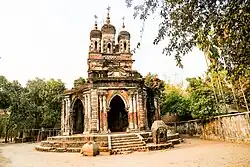Debiganj Upazila
দেবীগঞ্জ উপজেলা | |
|---|---|
 Golok Dham Temple | |
.svg.png.webp) | |
| Coordinates: 26°7.1′0″N 88°45.6′0″E / 26.11833°N 88.76000°E | |
| Country | |
| Division | Rangpur |
| District | Panchagarh |
| Headquarters | Debiganj |
| Area | |
| • Total | 309.04 km2 (119.32 sq mi) |
| Population (2011) | |
| • Total | 224,709 |
| • Density | 730/km2 (1,900/sq mi) |
| Time zone | UTC+6 (BST) |
| Postal code | |
| Website | debiganj |
Debiganj (Bengali: দেবীগঞ্জ) is an upazila of Panchagarh District in the Division of Rangpur, Bangladesh.[1]
Geography
Debiganj Upazila is located at 26°07′07″N 88°45′33″E / 26.11858°N 88.759299°E. It has 52,411 households and total area 309.04 km2.
It is bounded by Boda and Panchagarh Sadar upazilas on the north, Birganj, Khansama and Nilphamari Sadar upazilas on the south, Domar upazila and West Bengal state of India on the east, Thakurgaon Sadar and Boda upazilas on the west.[2]
Demographics
According to the 2011 Bangladesh census, Debiganj Upazila had 52,411 households and a population of 224,709. 55,235 (24.58%) were under 10 years of age. Debiganj had a literacy rate (age 7 and over) of 47.69%, compared to the national average of 51.8%, and a sex ratio of 986 females per 1000 males. 15,301 (6.81%) lived in urban areas.[3][4]
As of the 1991 Bangladesh census, Debiganj has a population of 159902. Males constitute 51.02% of the population, and females 48.98%. This Upazila's eighteen up population is 77660. Debiganj has an average literacy rate of 24.8% (7+ years), and the national average of 32.4% literate.[5]
Administration
Debiganj Thana was formed in 1928 and it was turned into an upazila on 28 March 1983.[2]
The Upazila is divided into ten union parishads: Chengthi Hazradanga, Chilahati, Dandopal, Debiduba, Debiganj, Pamuli, Shaldanga, Sonahar Mollikadaha, Sundardighi, and Tepriganj. The union parishads are subdivided into 108 mauzas and 101 villages.[3]
Education
Nripendra Narayan Government High School, founded in 1906, is a notable secondary school in the upazila.[1]
Debiganj Alodini Government Girls High School is a secondary government high school here. It also has a reputed college. Overall Debiganj has 68 govt and non-govt high schools and 10 colleges. Some of them are -
- Sonahar Girls High School
- Sonahar High School
- Khariza Sonahar High School
- Saldanga High School
- TZ High School
- Debigonj Girls' High School
- Debigonj Pailot High School.
References
- 1 2 Habib, Md Ahsan (2012). "Debiganj Upazila". In Islam, Sirajul; Jamal, Ahmed A. (eds.). Banglapedia: National Encyclopedia of Bangladesh (Second ed.). Asiatic Society of Bangladesh.
- 1 2 "Debiganj Upazila - Banglapedia". en.banglapedia.org. Retrieved 21 February 2023.
- 1 2 3 "Bangladesh Population and Housing Census 2011 Zila Report – Panchagarh" (PDF). bbs.gov.bd. Bangladesh Bureau of Statistics.
- ↑ "Community Tables: Panchagarh district" (PDF). bbs.gov.bd. Bangladesh Bureau of Statistics. 2011.
- ↑ "Population Census Wing, BBS". Archived from the original on 27 March 2005. Retrieved 10 November 2006.
